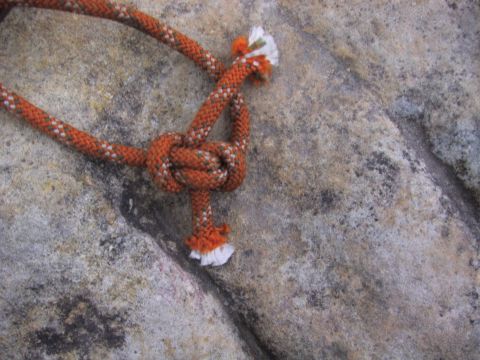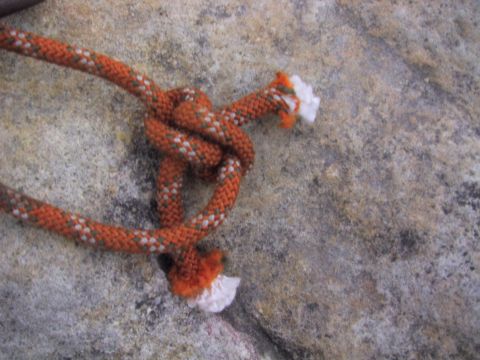This knot was found on a sling at the top of Malaita Wall (from memory). I didn't recognise the knot. It is tied in approx. 7mm cord. Would you abseil off this??


After much debate, we are agreed that the knot is a close relative of the Hunter's Bend. It may in fact be a Hunter's Bend, as there are a couple of different descriptions of how to tie it, one of which results in the above knot. It is one of a family of knots comprising two interlocked overhand knots. It is probably quite strong, and secure.
It also does look very similar to the Zeppelin Knot, but if you actually tie the knot shown in the pictures, one half of the knot is inverted compared to the Zeppelin Knot. Its symmetry is closer to Hunter's Bend, even though at first glance it looks less similar.
I didn't (and wouldn't) abseil off it. There's no need. I've come across this knot again a few times more recently - in Devils Pinch Canyon, and in Pipeline Canyon, amongst others. In Devils Pinch, I retied the sling with a double fishermans, and I didn't use the sling in Pipeline Canyon.
There are a few reasons I wouldn't abseil off it, but the main one is that I don't recognise the knot. And because I don't recognise it, I don't know how strong or secure the knot is.
Another reason is that it is difficult to identify. It looks like a Hunter's Bend. But then I tied a Hunter's Bend and another similar knot, comparing it to the pictures, and it was neither of them - even though it was extremely similar. I managed to replicate the knot after maybe an hour of trying, and it was nothing I could find in any reference. Easy identification and confirmation that you have tied a knot correctly is a good reason to use knots such as figure-8s, EDKs and Double Fishermans. It is also a reason not to use the Alpine Butterfly Bend - it's not easy to tell at a glance that it has been tied correctly/
To quote another web page on Hunter's Bend (and similar commentary on the Zeppelin Bend):
Tying it: The arrangement of the interlocking loops and the path of the ends through the center are critical. Similarity to other bends employing interlocking overhand knots invites confusion - and mistakes.
If you want another reason not to use knots that can be easily confused, look up the Thief Knot!